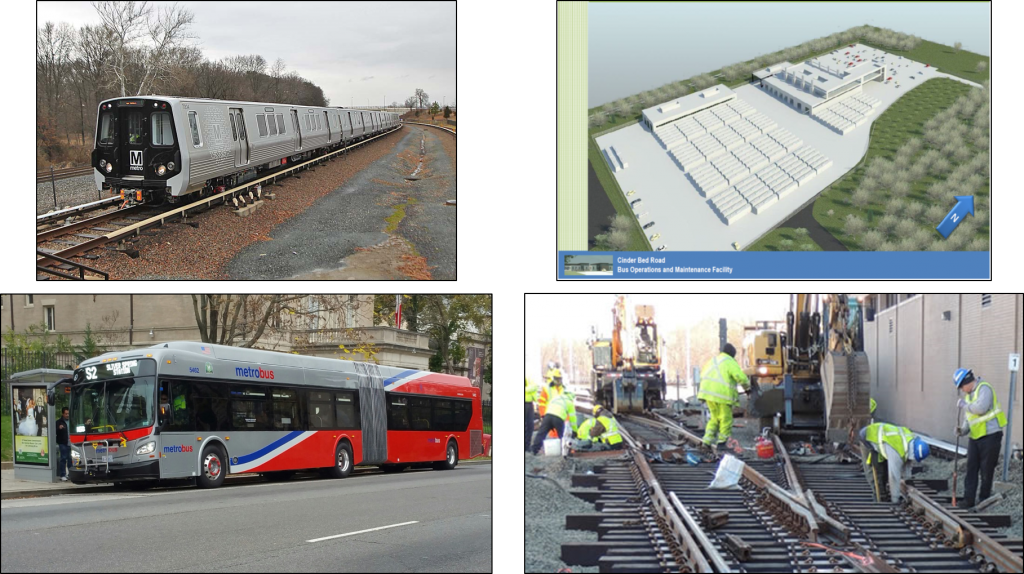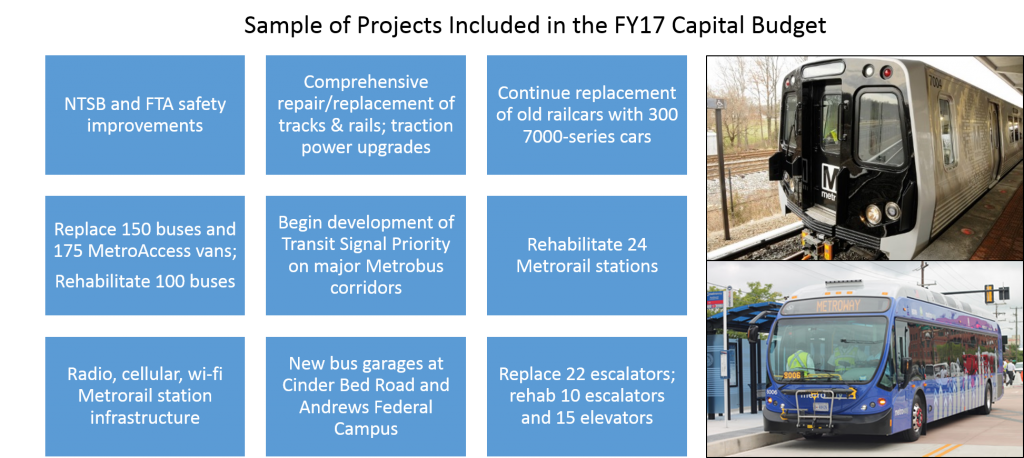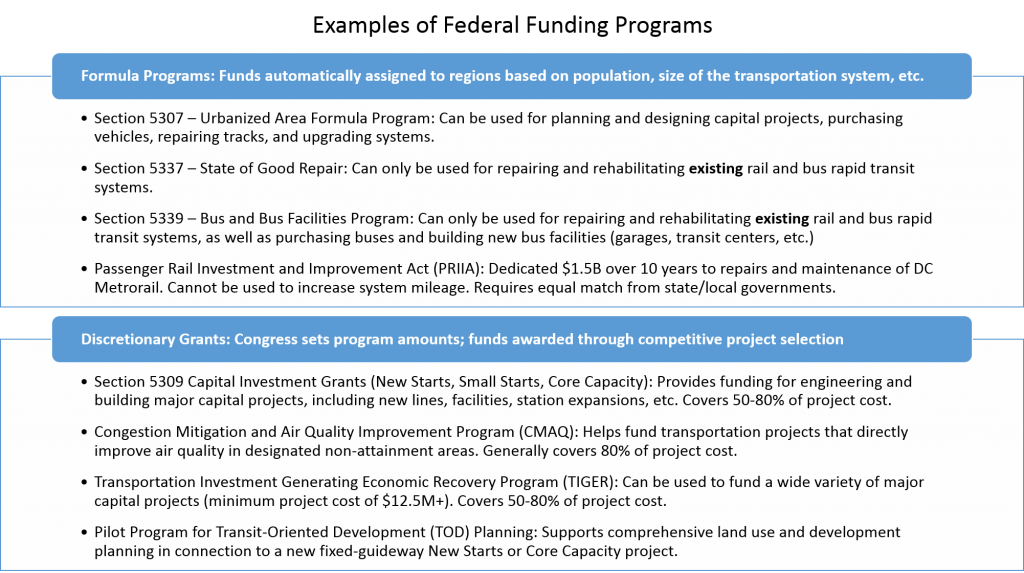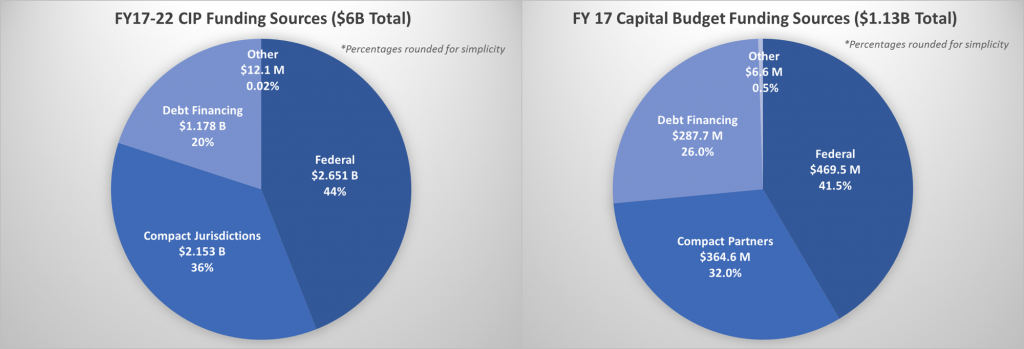Squaring Circles: De-Mystifying Metro’s Budget and Funding Sources (Part Two of Three)
As Metro kicks off its public engagement effort for next year’s capital and operating budgets, now is the perfect time to get involved in helping shape the Authority’s priorities for the next few years!
This is the second of three related posts that attempt to de-mystify transit funding and give the residents of Metro’s service area some tools to engage in budget discussions. The first post focused on the Capital Funding Agreement (CFA, PDF) and the Capital Improvement Program (CIP, PDF), which together establish a six-year framework for funding projects that improve the Metro System’s safety, reliability, and performance. This post focuses on how the CIP translates into an annual capital budget, and the next post will explore the annual operating budget.
The budget creation process starts in September of each year, with staff from Metro, Compact jurisdictions, and the Federal Transit Administration (FTA) working together to forecast population growth, job growth, ridership, fare and parking revenues, and the amount of federal, state, and local funding likely to be available over the next six years. Metro’s budget staff and management team then draft an updated CIP and a detailed budget for the next fiscal year, present it to Metro’s Board of Directors, and prepare for a public engagement process. The current CIP runs from Fiscal Year 2016 to 2021 (remember, Metro’s fiscal years begin on July 1 and end on June 30; we are currently in FY16). This spring, Metro’s Board of Directors will adopt a budget for FY 2017 and an updated CIP that covers FY17-22. The graphic below illustrates this process:
The capital budget pays for projects where Metro is building something or buying equipment: new buses and rail cars, building a new station entrance, improving a bus stop, or buying new parts for escalators. This is separate from the operating budget, which pays for running the system on a daily basis. The capital budget functions as the first year of the six-year CIP, and is the only year for which funding sources and amounts are dedicated to specific projects. The other five years of the CIP represent a general plan for the projects Metro and the Compact jurisdictions want to undertake given the financial resources likely to be available. The six-year CIP is meant to give Metro, the jurisdictions, and our customers a degree of certainty when planning large, multi-year projects such as the Metrobus Priority Corridor Network or buying new 7000-series railcars. However, the CIP is reviewed and updated every year, so is subject to change as new priorities are identified by the Board, the General Manager, or the FTA.
Why have two budgets? Capital projects are paid for with a wide variety of funding sources, many of which can only be spent on particular types of projects. This is a key difference between Metro’s capital and operating budgets, and one major reason we have two budgets. Customer fares and parking fees have no strings attached, but Metro uses them only to operate the services customers use. Federal grants can be used to build or buy things, but typically can only be spent on particular types of projects, and almost always require matching funds from state and local sources. On top of that, federal grants generally cannot be used for operating costs, unless Congress specifically allows that flexibility. This complexity turns every budget into a massive jigsaw puzzle of matching capital projects with the most appropriate funding source. In turn, the amounts and availability of those funding sources limit the types and number of projects Metro can pursue in any given year.
So what’s actually in the proposed budget? How will WMATA pay for those projects? The current drafts of the FY17-22 CIP and FY17 budget carry forward Metro’s focus on safety, repairs and replacements, and improving system performance. In fact, these budget documents are intended to support five key goals:
- Funding critical safety and security investments for customers and employees
- Supporting service initiatives to regain customers’ trust and boost ridership
- Reducing costs and improving efficiency
- Maintaining current fares, service levels, and total jurisdictional subsidy
- Committing to continued CIP investment as part of a renewed CFA
Projects identified as meeting those goals were selected from NTSB and FTA safety recommendations, departmental safety and maintenance priorities, and the Momentum strategic plan. Major projects include the replacement of 1000-series railcars with new 7000-series railcars; beginning the implementation and development of Transit Signal Priority on the Metrobus Priority Corridor Network (with federal TIGER funds); upgrading infrastructure to improve radio, cellular, and eventually wi-fi service in Metrorail tunnels; and comprehensive repair and replacement of rail tracks, signals, and power supply. The entire draft CIP is dedicated to projects that improve the Metro System’s safety, reliability, and customer experience. The FY17 budget includes projects like:
If approved, the price tag for these projects in FY 2017 alone will be $1.13 billion, and the entire six-year CIP is projected to cost $6 billion. The WMATA Compact and CFA encourage Metro to use federal funds for projects like these, and commit the Compact jurisdictions to providing the local matching funds for federal grants. There are two basic types of federal transportation grants, formula and discretionary. Formula funds are authorized by Congress for general purposes (planning projects, purchasing vehicles, building facilities, repairing systems, etc.) and are automatically distributed to states and regions according to formulas based on things like population density, size of the transit system, and demographics. Discretionary grants are typically tied to more specific purposes and project types, and must be won through a competitive application and project evaluation process. WMATA routinely uses formula funds and local matching funds to support the CIP, but could make more use of discretionary funds if staff and jurisdictional partners believe the reward is worth the effort and resources. The table below provides examples of common formula and discretionary grant programs. It also illustrates the use limitations and local matching requirements that accompany all federal capital funds:
The FTA has estimated that the National Capital Region should receive approximately $360 million in federal formula funds for FY17. That amount would be 8% higher than the formula funds received in FY16. The money would be shared between WMATA, the Potomac and Rappahannock Transportation Commission (PRTC), and the Maryland Transit Administration (MTA). If the sharing agreement remains similar to previous years, WMATA should receive approximately 86% of those funds, or $310 million. When Congress passed the FAST Act, it also re-committed to an annual Passenger Rail Investment and Improvement Act (PRIIA) award of $148.5 million, which must be matched by an equal amount of local funds from the District of Columbia, Maryland, and Virginia. Those programs, combined with a smaller set of discretionary grants, total $469.5 million in federal support for the FY17 capital budget.
But because WMATA does not have its own dedicated funding source, any project costs not covered by federal money or fees from advertising, franchises, and real estate transactions must be covered by the Compact jurisdictions and their taxpayers. Those costs are billed to each jurisdiction according to the same Allocation Formula that applies to Metro’s operating subsidy, and are defined in the CFA and budget documents as “System Performance Funds.” The proposed breakdown of capital funds for the FY17-22 CIP and FY17 capital budget is shown in the charts below:
Keep in mind, all of this is still a draft recommendation. The budget still needs to be reviewed and commented on by Metro’s customers and Compact residents, as well as approved by Metro’s Board of Directors.
Metro is about to launch a community engagement process for the FY17 budget and FY17-22 CIP. The public comment period begins this Saturday, February 6th, and will run until 9am on Monday, February 29th. Customers are encouraged to submit their feedback the following ways:
- Take an online survey!
- Email your written comments to writtentestimony@wmata.com.
- Give feedback to project staff at these locations/dates:
- Rosslyn Station, Tuesday, February 16, 4-7 p.m.
- Fort Totten Station, Wednesday, February 17, 4-7 p.m.
- Anacostia Station, Thursday, February 19, 4-7 p.m.
- Attend a formal public hearing at Metro Headquarters, 600 5th St NW, Washington DC, on Monday, February 22. An open house will begin at 6 p.m. and the Public Hearing will begin at 6:30 p.m.
Additional communications and outreach efforts will continue over the next few weeks, including notification to local stakeholders and community based organizations; signs posted in Metrorail stations, Metrobuses, and MetroAccess vehicles; surveys sent to a statistical sample of registered SmarTrip cardholders; ads in local English and non-English publications; and other efforts such as advisories, press releases, and social media. The online survey and legal notice will also be available in 7 languages.
Staff will summarize and present community feedback to the Board in March, and the Board will use that feedback as a vital input in budget negotiations before adopting a final budget in April.
So be on the lookout for opportunities to learn more about next year’s budgets and to have your voice heard! This is your best opportunity to have input on the projects Metro and its jurisdictional partners will undertake over the next six years.








Hello, PlanIt readers! I just wanted to give everyone a heads-up that Metro’s budget webpage and the hyperlinked survey will be updated with a current version later today. Remember the official public comment period doesn’t start until tomorrow (Saturday 2/6). Thank you!